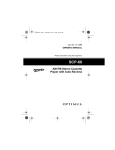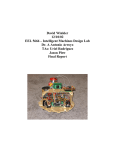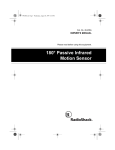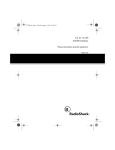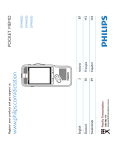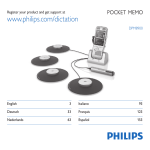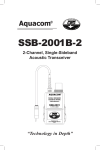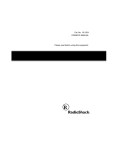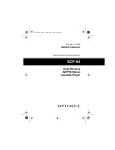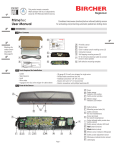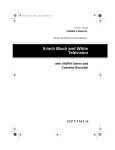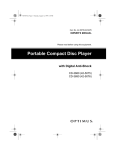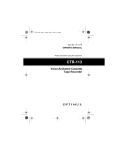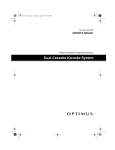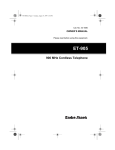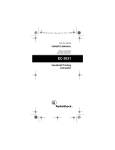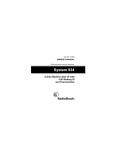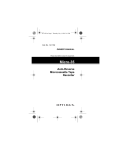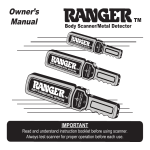Download Optimus CD-3690 (42-5076) CD Player User Manual
Transcript
14-1111.fm Page 1 Thursday, July 1, 1999 12:55 PM Cat. No. 14-1111 OWNER’S MANUAL Please read before using this equipment. CTR-106 Voice-Activated Cassette Tape Recorder 14-1111.fm Page 2 Thursday, July 1, 1999 12:55 PM FEATURES Your Optimus CTR-106 Voice-Activated Cassette Tape Recorder gives you a convenient and reliable way to record live audio. You can manually start recording or set the CTR-106 to automatically start recording when the recorder picks up sound. Because the CTR-106 does not record long periods of silence, you not only save tape space and battery power, you also save time when you try to find a certain section on the tape. Your recorder is small enough to fit in a briefcase or purse, so you can take it almost anywhere — meetings, lectures, and so on. The cassette recorder includes these special features: Voice-Activated Circuit — automatically starts recording when the recorder picks up sound and stops recording within 5 seconds after the sound falls below a set level. Built-In Condenser Microphone — helps provide quality recordings. Digital Tape Counter — helps you quickly return to a specific section on the tape. © 1997 Tandy Corporation. All Rights Reserved. Optimus and RadioShack are registered trademarks used by Tandy Corporation. 2 14-1111.fm Page 3 Thursday, July 1, 1999 12:55 PM Automatic Level Control (ALC) Circuit — automatically adjusts to the proper recording level. Auto Stop — during playback and recording, stops the recorder and releases the tape mechanism when the tape reaches the end, to save battery power and protect your cassette tape. Three-Way Power — lets you operate your cassette recorder using internal batteries, an AC outlet (using an optional adapter), or your vehicle’s cigarette-lighter socket (using an optional adapter). Earphone — lets you listen without disturbing others. You can also use the earphone to monitor a recording and check the microphone’s sensitivity. Built-In Speaker — lets you listen to your recorder without an earphone. 3 14-1111.fm Page 4 Thursday, July 1, 1999 12:55 PM CONTENTS Preparation .................................................................. 5 Powering the Recorder ........................................... 5 Using Internal Battery Power ........................... 5 Using AC Power ............................................... 7 Using DC Power .............................................. 9 Using the Earphone .............................................. 11 Listening Safely .............................................. 12 Traffic Safety .................................................. 12 Operation ................................................................... Loading a Cassette Tape ...................................... Playing a Tape ...................................................... Using Fast-F and Rewind ..................................... Using the Tape Counter ........................................ Recording ............................................................. Using Voice Activation (VOX) ........................ Manual Recording .......................................... Tape Tips .............................................................. Restoring Tape Tension and Sound Quality ... Preventing Accidental Erasure ....................... Erasing a Cassette Tape ................................ 13 13 14 15 15 16 16 17 18 18 18 19 Maintenance .............................................................. 20 Cleaning the Tape-Handling Parts ........................ 21 Specifications ............................................................ 23 4 14-1111.fm Page 5 Thursday, July 1, 1999 12:55 PM PREPARATION POWERING THE RECORDER For portable use, you can power the recorder from internal batteries. You can also power it from a standard AC outlet or your vehicle’s cigarette-lighter socket. Using Internal Battery Power The recorder uses two AA batteries. For the best results, we recommend alkaline batteries, such as RadioShack Cat. No. 23-552. Or, you can use rechargeable nickelcadmium batteries, such as Cat. No. 23-125, with a battery charger (Cat. No. 23-133). Cautions: • Use only fresh batteries of the recommended size and type. • Do not mix old and new batteries, different types of batteries (standard, alkaline, or rechargeable), or rechargeable batteries of different capacities. 5 14-1111.fm Page 6 Thursday, July 1, 1999 12:55 PM Follow these steps to install batteries. Illust. 1. Slide the battery compartment cover in the direction shown by the arrow on the cover. 2. Install two AA batteries as indicated by the polarity symbols (+ and –) marked on the back of the recorder. 3. Replace the cover. Cautions: • If you do not plan to use the recorder for a week or more, or you plan to use only another power source, remove the batteries. • Always dispose of old batteries promptly and properly. 6 14-1111.fm Page 7 Thursday, July 1, 1999 12:55 PM Important: Your recorder is capable of using rechargeable nickel-cadmium batteries. At the end of the batteries’ useful life, they must be recycled or disposed of properly. Contact your local, county, or state hazardous waste management authorities for information on recycling or disposal programs in your area. Some options that might be available are: municipal curbside collection, drop-off boxes at retailers, recycling collection centers, and mailback programs. Using AC Power To power the recorder from an AC outlet, you need an AC adapter (not supplied), such as Cat. No. 273-1654. Cautions: • You must use an adapter that supplies 3 volts and delivers at least 300 milliamps. Its center tip must be set to negative, and it must have a plug that properly fits the CTR-106’s DC 3V jack. The recommended adapter meets these specifications. Using an adapter that does not meet these specifications could damage the CTR-106 or the adapter. • Connecting an AC adapter automatically disconnects internal batteries. 7 14-1111.fm Page 8 Thursday, July 1, 1999 12:55 PM • Always plug the adapter into the recorder before you plug it into the AC outlet. Always unplug the adapter from the AC outlet before you unplug it from the recorder. Illust. 1. Set the adapter’s voltage switch to 3V. 2. Attach the 3.4 mm outer diameter/1.3 mm inner diameter barrel plug to the AC adapter’s cord with the tip set to negative (–). 3. Insert the plug into the recorder’s DC 3V jack. 4. Plug the adapter into a standard AC outlet. 8 14-1111.fm Page 9 Thursday, July 1, 1999 12:55 PM Using DC Power To power the recorder from your vehicle’s cigarette-lighter socket, you need a DC adapter (not supplied), such as Cat. No. 270-1560. Cautions: • You must use an adapter that supplies 3 volts and delivers at least 300 milliamps. Its center tip must be set to negative, and it must have a plug that properly fits the CTR-106’s DC 3V jack. The recommended adapter meets these specifications. Using an adapter that does not meet these specifications could damage the CTR-106 or the adapter. • Connecting a DC adapter automatically disconnects internal batteries. • Always plug the adapter into the recorder before you plug it into the cigarette-lighter socket. Always unplug the adapter from the cigarette-lighter socket before you unplug it from the recorder. 9 14-1111.fm Page 10 Thursday, July 1, 1999 12:55 PM Follow these steps to power the recorder from your vehicle’s cigarette-lighter socket. Illust. 1. Set the adapter’s voltage switch to 3V. 2. Attach the 3.4 mm outer diameter/1.3 mm inner diameter barrel plug to the DC adapter’s cord with the tip set to negative (–). 3. Insert the plug into the recorder’s DC 3V jack. 4. Plug the adapter into the vehicle’s cigarette-lighter socket. Note: If the recorder does not operate properly when powered from your vehicle’s battery, unplug the adapter from the cigarette-lighter socket and clean the socket to remove any ashes or other debris. 10 14-1111.fm Page 11 Thursday, July 1, 1999 12:55 PM USING THE EARPHONE You can use the earphone for private listening. You can also monitor a recording and check the microphone’s sensitivity (see “Using Voice Activation (VOX)” on Page 16). Insert the earphone’s 1/8-inch plug into the EAR jack. Illust. Note: Connecting the earphone disconnects the recorder’s built-in speaker. 11 14-1111.fm Page 12 Thursday, July 1, 1999 12:55 PM Listening Safely To protect your hearing, follow these guidelines when you use an earphone. • Do not listen at extremely high volume levels. Extended high-volume listening can lead to permanent hearing loss. • Set the volume to its lowest level before you begin listening. After you put on the earphone, adjust the volume to a comfortable listening level. • Do not increase the volume once you have established a comfortable listening level. Over time, your ears adapt to the volume level, so a volume level that does not cause discomfort might still damage your hearing. Traffic Safety Do not wear an earphone while operating a motor vehicle or riding a bicycle. This can cause a traffic hazard and could be illegal in some areas. Even though some earphones let you hear outside sounds when listening at normal volume levels, they still can present a traffic hazard. 12 14-1111.fm Page 13 Thursday, July 1, 1999 12:55 PM OPERATION LOADING A CASSETTE TAPE 1. Take up any slack in the cassette tape by turning the hub with a pencil to prevent the tape from becoming tangled in the tape mechanism. Do not touch the tape. Illust. 2. Open the cassette compartment door by lifting it at the notch. Insert a cassette tape into the door guides so the cassette’s open edge faces out, the side you want to play or record on faces the compartment window, and the full reel is to the left. Illust. 3. Close the cassette compartment door. 13 14-1111.fm Page 14 Thursday, July 1, 1999 12:55 PM PLAYING A TAPE 1. Load a cassette. 2. Press PLAY. Illust. 3. Adjust VOLUME to the desired level. Illust. STOP or let the tape auto4. To stop the tape, press matically stop when it reaches the end. 14 14-1111.fm Page 15 Thursday, July 1, 1999 12:55 PM USING FAST-F AND REWIND FAST-F To rapidly advance or rewind the tape, press REWIND. The button locks, and the tape fast-foror STOP. wards or rewinds to the end or until you press STOP to reWhen the tape reaches the end, press lease the button and the tape-handling parts. Illust. USING THE TAPE COUNTER The tape counter shows you the tape’s current playing position, making it easier to locate a particular segment. Before you play a tape, press the reset button to reset the counter to 000. As the tape plays, note the position you want to return to later. Illust. 15 14-1111.fm Page 16 Thursday, July 1, 1999 12:55 PM RECORDING Notes: • We recommend you use normal bias (Type I) cassette tapes, such as RadioShack LN and XR tape. • We recommend regular length (60- or 90-minute) cassette tapes. We do not recommend long-play cassette tapes, such as C-120s, because they are thin and can easily tangle. • The ALC (automatic level control) circuit automatically sets the recording level. VOLUME has no effect. RECORD after you Caution: Never try to force down remove an erase protection tab (see “Preventing Accidental Erasure” on Page 18). You might damage the recorder. Using Voice Activation (VOX) 1. Load a blank cassette (or one you want to record over) into the tape compartment. 2. Set VOICE ACTIVATION to IN. Illust. 16 14-1111.fm Page 17 Thursday, July 1, 1999 12:55 PM 3. Press RECORD. Recording begins when the voiceactivation mechanism detects a sound. Illust. 4. To cause soft sound levels to activate recording, rotate VOLUME/VOX SENS toward MAX. To automatically record only louder sounds, rotate VOLUME/VOX SENS toward MIN. (This does not change the volume of the recording.) The RECORD BATTERY indicator lights during recording. The louder the sound, the brighter the indicator glows. Manual Recording Set VOICE ACTIVATION to OUT, then press RECORD to record continuously. For the best quality recordings, place the recorder 1 to 5 feet from the sound source. Recording automatically stops when the recorder reaches the end of the tape side. To manually stop recording, press STOP. 17 14-1111.fm Page 18 Thursday, July 1, 1999 12:55 PM TAPE TIPS Restoring Tape Tension and Sound Quality After you play a cassette tape several times, the tape might become tightly wound on the reels. This can cause playback sound quality to deteriorate. To restore the sound quality, fast-forward the tape from the beginning to the end of one side, then completely rewind it. Then loosen the tape reels by gently tapping each side of the cassette’s outer shell on a flat surface. Caution: Be careful not to damage the cassette when tapping it. Do not touch the exposed tape or allow any sharp objects near the cassette. Preventing Accidental Erasure Cassette tapes have two eraseprotection tabs — one for each side. When a tab is in place, you can record on that side. To protect a recording from being accidentally recorded over or erased, use a screwdriver to remove one or both of the cassette tape’s erase-protection tabs. 18 Illust. 14-1111.fm Page 19 Thursday, July 1, 1999 12:55 PM If you later decide to record on a tape side after you have removed the erase-protection tab, place a piece of strong plastic tape over that side’s erase-protection hole. Be sure you cover only the hole originally covered by the erase-protection tab. Illust. Caution: Removing the erase-protection tabs does not prevent a bulk eraser from erasing a cassette tape. Erasing a Cassette Tape To record over a cassette tape, simply record as usual. The cassette deck records over the previous recording. You can quickly erase both sides of a cassette tape using a bulk tape eraser, such as Cat. No. 44-232. 19 14-1111.fm Page 20 Thursday, July 1, 1999 12:55 PM MAINTENANCE Your CTR-106 Voice-Activated Cassette Tape Recorder is an example of superior design and craftsmanship. The following suggestions will help you care for your recorder so you can enjoy it for years. Keep the recorder dry. If it gets wet, wipe it dry immediately. Liquids might contain minerals that can corrode the electronic circuits. Use and store the recorder only in normal temperature environments. Temperature extremes can shorten the life of electronic devices and distort or melt plastic parts. Keep the recorder away from dust and dirt, which can cause premature wear of parts. Handle the recorder gently and carefully. Dropping it can damage circuit boards and cases and can cause the recorder to work improperly. 20 14-1111.fm Page 21 Thursday, July 1, 1999 12:55 PM Use only fresh batteries of the required size and type. Batteries can leak chemicals that damage your recorder’s electronic parts. Wipe the recorder with a damp cloth occasionally to keep it looking new. Do not use harsh chemicals, cleaning solvents, or strong detergents to clean the recorder. Modifying or tampering with the recorder’s internal parts can cause a malfunction and might invalidate your recorder’s warranty. If your recorder is not operating as it should, take it to your local RadioShack store for assistance. CLEANING THE TAPE-HANDLING PARTS Dirt, dust, or particles of the tape’s coating can accumulate on the tape heads and other parts that the tape touches. This can greatly reduce the performance of the cassette player. To prevent noise and poor high-frequency response, clean the cassette player’s tape-handling parts after about 20 hours of use. Your local RadioShack store sells cassette deck head-cleaning kits. 21 14-1111.fm Page 22 Thursday, July 1, 1999 12:55 PM 1. Disconnect all power sources. 2. Open the cassette compartment door. 3. Hold down the erase protection tab sensor, then press RECORD to expose the tape-handling parts. 4. Use a cotton swab dipped in denatured alcohol or tape head-cleaning solution to clean the record/play head, pinch roller, capstan, erase head, and tape guides. Illust. 5. When you finish cleaning, press STOP and close the compartment. Then reconnect power. 22 14-1111.fm Page 23 Thursday, July 1, 1999 12:55 PM SPECIFICATIONS Tape System .................... 2 Track, Monophonic Cassette (For use with normal bias tape (Type I) only) Tape Speed..................................... 17/8 ips (4.75 cm/sec) Wow and Flutter....................................... 0.35% (WRMS) Signal-to-Noise Ratio...............................................42 dB Erase System ....................................................... Magnet Record System .................................................... AC Bias Power Requirements: DC ......................Two AA Batteries (Cat. No. 23-552) or 12 Volts from a Vehicle’s Cigarette-Lighter Socket with DC Auto Adapter, 3 Volt DC Output (Cat. No. 270-1560) AC ................................... 120 Volts with AC Adapter, 3 Volt DC Output (Cat. No. 273-1654) Size (HWD)................................. 51/16 × 31/2 × 11/4 Inches (128 × 89 × 32 mm) Weight..................................................................... 7.1 oz (201 g) Specifications are typical; individual units might vary. Specifications are subject to change and improvement without notice. 23 14-1111.fm Page 24 Thursday, July 1, 1999 12:55 PM Limited Ninety-Day Warranty This product is warranted by RadioShack against manufacturing defects in material and workmanship under normal use for ninety (90) days from the date of purchase from RadioShack company-owned stores and authorized RadioShack franchisees and dealers. EXCEPT AS PROVIDED HEREIN, RadioShack MAKES NO EXPRESS WARRANTIES AND ANY IMPLIED WARRANTIES, INCLUDING THOSE OF MERCHANTABILITY AND FITNESS FOR A PARTICULAR PURPOSE, ARE LIMITED IN DURATION TO THE DURATION OF THE WRITTEN LIMITED WARRANTIES CONTAINED HEREIN. EXCEPT AS PROVIDED HEREIN, RadioShack SHALL HAVE NO LIABILITY OR RESPONSIBILITY TO CUSTOMER OR ANY OTHER PERSON OR ENTITY WITH RESPECT TO ANY LIABILITY, LOSS OR DAMAGE CAUSED DIRECTLY OR INDIRECTLY BY USE OR PERFORMANCE OF THE PRODUCT OR ARISING OUT OF ANY BREACH OF THIS WARRANTY, INCLUDING, BUT NOT LIMITED TO, ANY DAMAGES RESULTING FROM INCONVENIENCE, LOSS OF TIME, DATA, PROPERTY, REVENUE, OR PROFIT OR ANY INDIRECT, SPECIAL, INCIDENTAL, OR CONSEQUENTIAL DAMAGES, EVEN IF RadioShack HAS BEEN ADVISED OF THE POSSIBILITY OF SUCH DAMAGES. Some states do not allow the limitations on how long an implied warranty lasts or the exclusion of incidental or consequential damages, so the above limitations or exclusions may not apply to you. In the event of a product defect during the warranty period, take the product and the RadioShack sales receipt as proof of purchase date to any RadioShack store. RadioShack will, at its option, unless otherwise provided by law: (a) correct the defect by product repair without charge for parts and labor; (b) replace the product with one of the same or similar design; or (c) refund the purchase price. All replaced parts and products, and products on which a refund is made, become the property of RadioShack. New or reconditioned parts and products may be used in the performance of warranty service. Repaired or replaced parts and products are warranted for the remainder of the original warranty period. You will be charged for repair or replacement of the product made after the expiration of the warranty period. This warranty does not cover: (a) damage or failure caused by or attributable to acts of God, abuse, accident, misuse, improper or abnormal usage, failure to follow instructions, improper installation or maintenance, alteration, lightning or other incidence of excess voltage or current; (b) any repairs other than those provided by a RadioShack Authorized Service Facility; (c) consumables such as fuses or batteries; (d) cosmetic damage; (e) transportation, shipping or insurance costs; or (f) costs of product removal, installation, set-up service adjustment or reinstallation. This warranty gives you specific legal rights, and you may also have other rights which vary from state to state. RadioShack Customer Relations, Dept. W, 100 Throckmorton St., Suite 600, Fort Worth, TX 76102 We Service What We Sell 3/97 RadioShack A Division of Tandy Corporation Fort Worth, Texas 76102 6A7 Printed in Hong Kong
























